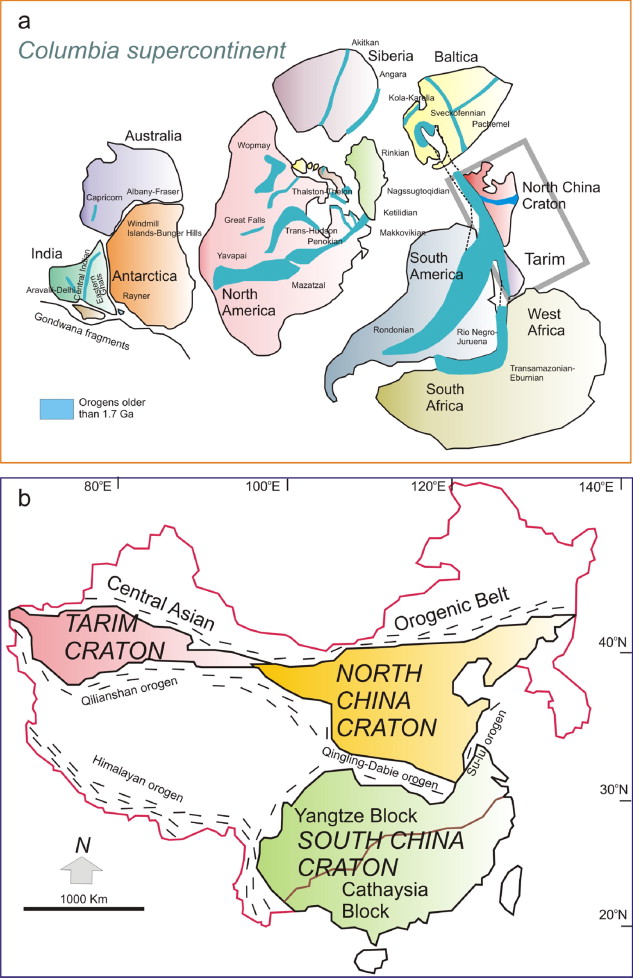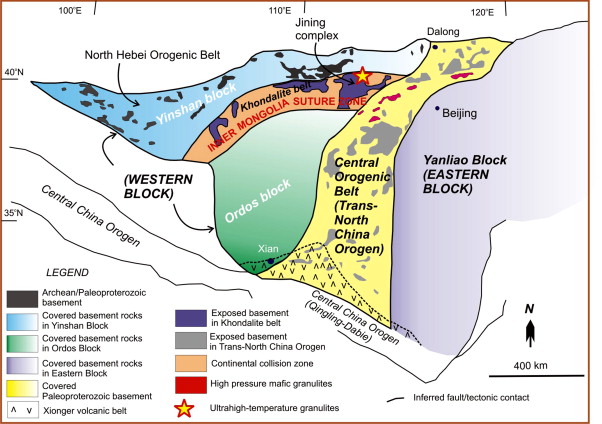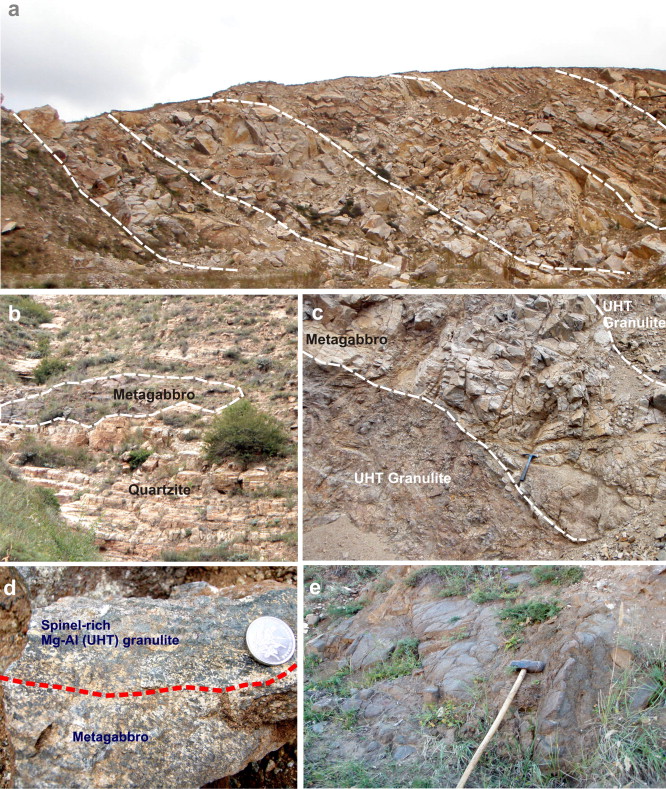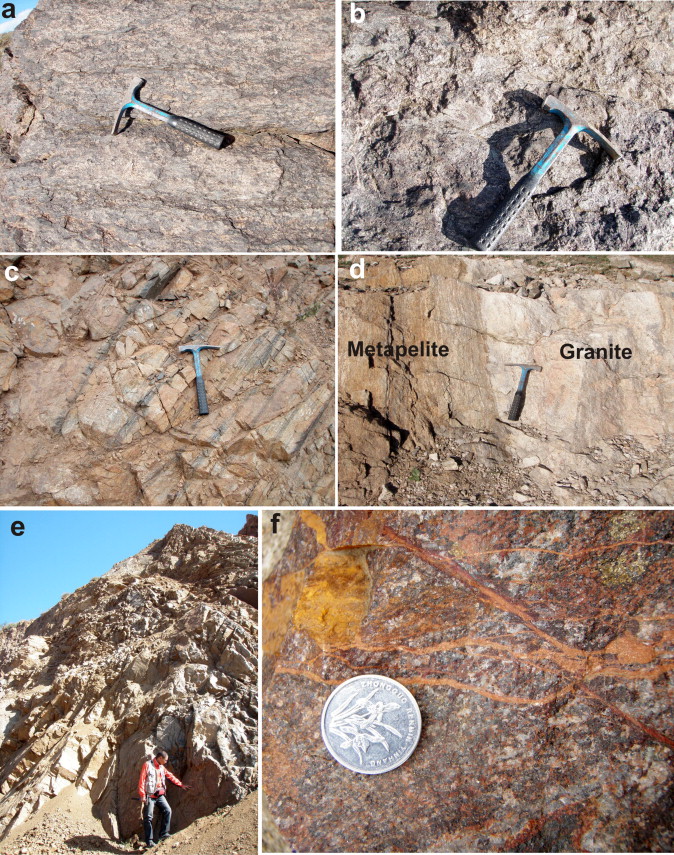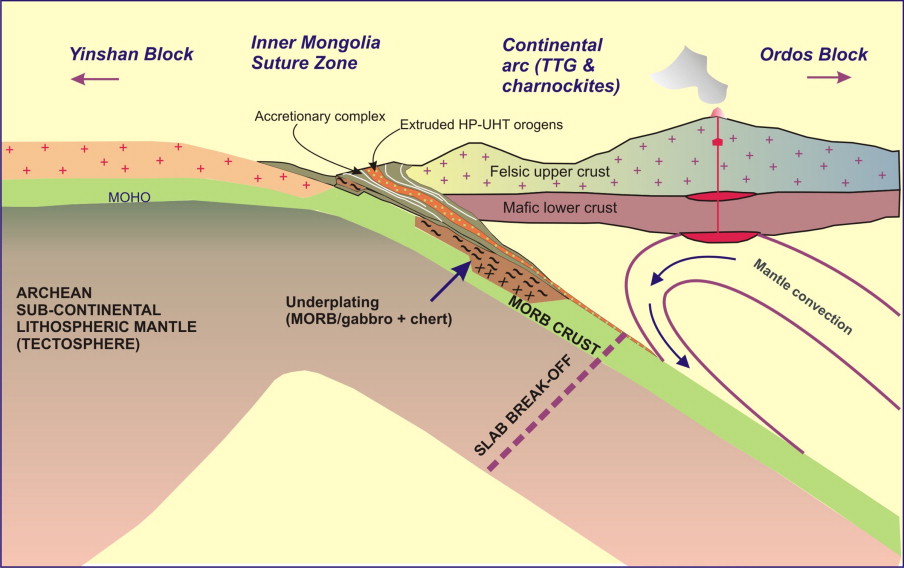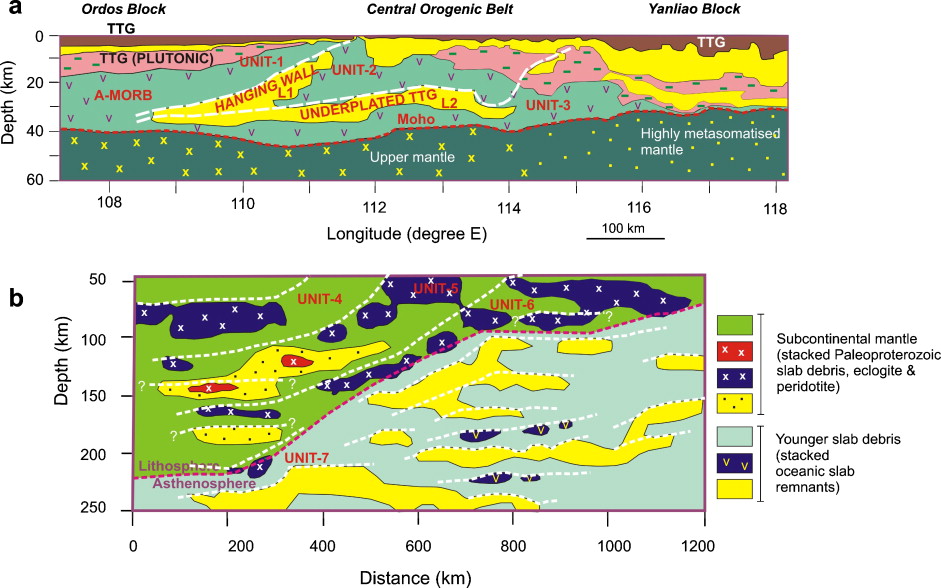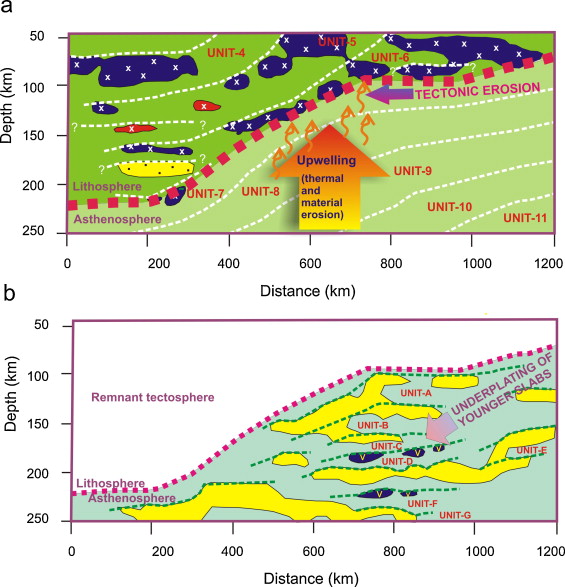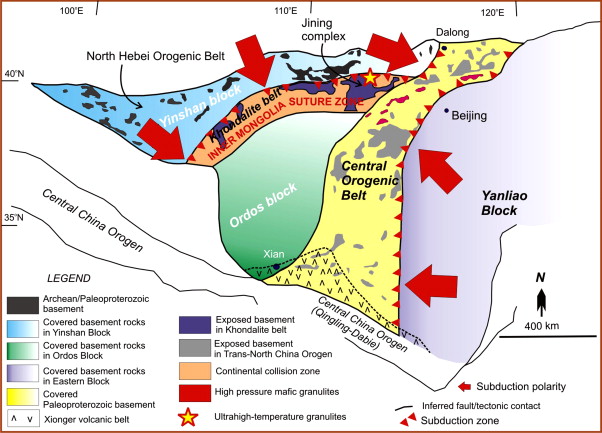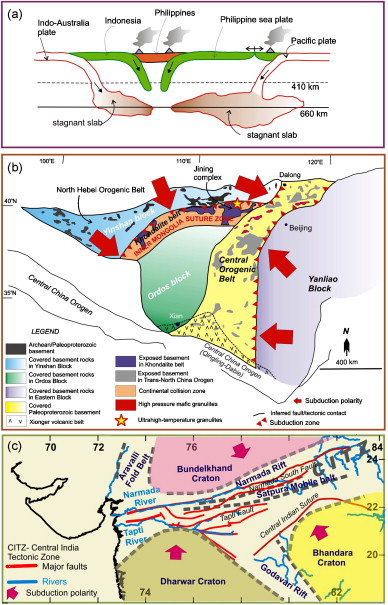 | North China Craton |
) North China Craton within the Paleoproterozoic Columbia supercontinent (after Kusky and Santosh, 2009). (b) Tectonic framework of China illustrating the major Precambrian cratons and younger orogens (after Zhao et al., 2005). |
Geologic and tectonic map of the North China Craton (compiled and revised after [83], [87], [27], [50] and [51]), showing the distribution of the main tectonic subdivisions. The locations of ultrahigh-temperature and high pressure orogens are also shown. The collision zone between the Yinshan and Ordos Blocks has been recently defined as the Inner Mongolia Suture Zone (Santosh et al., 2010). The Eastern Block is renamed in the present study as the Yanliao Block |
(a) Geological map of NCC showing four seismic profiles discussed in this study (AбьбьCAЎбьз╖, BбьбьCBЎбьз╖, CбьбьCCЎбьз╖, DбьбьCDЎбьз╖). (b) Migrated S-RF image for profile AбьбьCAЎбьз╖. (c) Migrated S-RF image for profile BбьбьCBЎбьз╖. (d) Synthetic model simulating the structure imaged from profile AбьбьCAЎбьз╖. Upper dashed line indicates Moho. (aбьбьCc) After Chen et al. (2008). |
(a) Seismic profile along transect CззCCЎз╒ (after Zheng et al., 2009) showing the crustal structure beneath Ordos Block, Central Orogenic Belt and Yanliao Block. (b) Interpretative sketch of tomographic profile along longitude 108Ўз╘E down to a depth of 600 km (transect AззCAЎз╒ in Fig. 3a, after Tian et al., 2009). (c) Interpretative sketch of seismic traverse along latitude 37Ўз╘N (after Xu and Zhao, 2009). This transect down to 800 km depth is approximately parallel to the AззCAЎз╒ profile of Chen et al. (2008) for the shallower region. The dashed line indicates the 410 km discontinuity defining the top of the mantle transition zone. |
The distribution of major lithological units within the Inner Mongolia Suture Zone (bound by the Yinshan Block to the north and Ordos Block to the south). The main lithological units in the Central Orogenic Belt (along which the Ordos Block to the west and the Yanliao Block to the east were amalgamated) are also shown. The base map is modified with new data (M. Santosh and S.J. Liu, unpublished) from the version compiled by Kusky et al. (2007a). The various localities discussed in the text are also marked |
Representative field photographs of the major lithological units from the Khondalite Belt within the Inner Mongolia Suture Zone. (a) North-verging thrust sheets of interlayerd metapelite and quartzite in the Hoh-hotбкHeligбпer section. (b) Metagabbros interlayered with quartzties and metapelites in the Xinghe section. (c) Ultrahigh-temperature granulite facies rocks interlayered with metagabbros showing imbricate structures around Danqingshan. (d) Hand specimen photograph showing the association of ultrahigh-temperature (UHT) granulite and metagabbro in the Daqingshan section. (e) Thick metagabbro layers and blocks south of the khondalite-leptynite sequence in Tuguiwula |
Field photographs of representative lithological units from the Inner Mongolia Suture Zone. (a and b) Sapphirine-bearing ultrahigh-temperature granulites from Tuguiwula. These rocks occurs as thin extruded belts in association with metagabbros within Jining khondalite unit. (c) TTG (tonalite-trondhjemite-graniodiorite) gneisses in the Xinghe section. (d) Sheet-like intrusion of calc-alkaline granites within the ultrahigh-temperature granulite section in Tuguiwula. (e) Extensive charnockite outcrops forming large hillocks in the Xinghe section. These are incorporated within a regional mega-sheath fold. (f) Banded iron formation with alternating iron-rich and silica-rich laminae from the Xinghe section |
. Cartoon sketch illustrating the proposed plate tectonic model for the formation of the Inner Mongolia Suture Zone through southward subduction of the Archean Yinshan Block with a possible thick lithospheric keel. The various lithological units in the khondalite belt are thought to represent an oceanic plate stratigraphy incorporated within an accretionary complex. According to this model, the high pressureиCultrahigh-temperature rocks were generated in a subduction setting which subsequently extruded as thin layers or were incorporated as disrupted blocks within the accretionary sequence. The association of amphibolites and metagabbros with quartzites is interpreted to represent an underplated sequence of oceanic lithosphere and sediments as schematically shown in the figure. According to this model, the TTG gneisses, charnockites and associated intrusives represent the deeply eroded root of a magmatic arc |
Interpretative sketches of seismic images. (a) Profile CиCCбф (after Zheng et al., 2009) showing the detailed crustal structure. (b) Migrated S-RF image along profile BиCBбф (after Chen et al., 2009) showing the topology of the subcontinental mantle down to 250 km. The various units shown envisage successive underplating and an eastward migration of the trench. |
The model proposed in this study to explain the formation of the layered structure of the sub-continental mantle lithosphere beneath the Ordos Block through westward subduction. (a) In the initial stage, the various units (units 1Ц11) were accreted by progressive subduction from the east during the Archean/Paleoproterozoic. Subsequently, extensive thermal and material erosion of the tectosphere occurred towards the east through asthenospheric upwelling and removal of units 7Ц11. The thick broken line marks the Сerosional planeТ as interpreted from the present day seismic data from Chen et al. (2009). (b) Successive underplating of younger oceanic slab (units AЦG) through subduction from the east resulting in the development of a layered structure similar to that observed for the tectosphere |
a) Cartoon illustrating the concept of double-sided subduction discussed in the text (after Santosh et al., 2009a). (b) Double-sided subduction in the Western Pacific region, considered as the frontier of a future supercontinent (after Maruyama et al., 2007). |
Geological map of the North China Craton showing the proposed subduction zones and inferred subduction polarity (thick arrows). |
(a) Cartoon illustrating the concept of double-sided subduction discussed in the text (after [51] and [87]). (b) Geological and tectonic framework of the North China Craton showing the assembly of crustal blocks through opposing subduction as interpreted from a recent synthesis of S-wave receiver functions, S-wave velocities and two versions of P-wave tomographic images along various transects in this craton (after Santosh, 2010). The assembly of the major crustal blocks within the North China Craton during the Paleoproterozoic and their incorporation within the Columbia supercontinent are correlated to double-sided subduction history. (c) The Central India Tectonic Zone (CITZ) that sutures the South and North Indian blocks. The major cratons are also shown. A combined geological and geophysical synthesis suggests double-sided subduction as a trigger for the Mesoproterozoic suturing event (after Naganjaneyulu and Santosh, in press).http://www.sciencedirect.com/science/article/pii/S0264370710000700 |
Assembling North China Craton within the Columbia supercontinent: The role of double-sided subduction. An evaluation of recent S-wave receiver functions, S-wave velocities and two versions of P-wave tomographic images along various transects in the North China Craton provides some clues on the subduction-collision history of the different crustal blocks and their final amalgamation within the Paleoproterozoic Columbia supercontinent. Interpretation of a N–S seismic section of the craton suggests thick slab debris sinking to various depths in the mantle. The W–E seismic corridors show the preservation of a thick (>200 km) lithospheric root (tectosphere) beneath the Ordos Block and its variable and extensive erosion towards the Yanliao Block (Eastern Block). This zone is characterized by layers with marked velocity contrast and suggests repeated stacking of the remnants of underplated and accreted Paleoproterozoic oceanic lithosphere. The present day lithosphere-asthenosphere boundary beneath this region probably marks the Ѓeerosional planeЃf along which decratonization occurred through subduction-erosion from the east and thermal and material erosion by upwelling asthenosphere from below resulting in the partial destruction of the tectosphere and its thinning towards the east. Within the asthenosphere below the Yanliao Block, younger and thinner slabs predominate, in the absence of any prominent thick high velocity layers. These younger slabs define a westward polarity and constitute a mega-scale duplex formed by underplating through Phanerozoic subduction process, particularly the Pacific plate subduction from the east.
The lithologic associations within the Inner Mongolia Suture Zone dividing the Yinshan Block to the north and Ordos Block to the south correspond to an accreted ocean plate stratigraphic sequence, with the tonalite-trondhjemite-granodiorite (TTG) gneisses, charnockites and calc-alkaline granites representing a continental arc built up through subduction from the north. The seismic transects bring out a contrasting polarity in the subduction regime with an oblique east- to southward subduction of the Yinshan Block and a westward subduction of the Yanliao Block. Here I propose a double-sided subduction history for the NCC, similar to the ongoing subduction process in the Western Pacific. Such double-sided subduction is considered to promote rapid amalgamation of continental fragments within supercontinents and the subduction polarities and mantle dynamics of NCC are therefore considered to be critical in evaluating the final assembly of the Paleoproterozoic supercontinent Columbia.Keywords Seismic tomography; Subduction polarity; Tectonics; Ocean Plate Stratigraphy; North China Craton; Columbia supercontinent
Assembling North China Craton within the Columbia supercontinent: The role of double-sided subduction
http://www.sciencedirect.com/science/article/pii/S0301926810000446
The Inner Mongolia Suture Zone marks the Paleoproterozoic collisional boundary between the Yinshan Block and Ordos Block in the North China Craton. The ultrahigh-temperature (UHT) orogen developed within this collisional suture reflects the extreme thermal conditions associated with the tectonic processes during the incorporation of the North China Craton within the Columbia supercontinent. Here we report the results from a systematic petrological and phase equilibria modeling study of sapphirine-bearing granulites from Daqingshan, a region within the central domain of the Inner Mongolia Suture Zone. The sapphirineЦspinelЦgarnetЦsillimaniteЦbiotite-bearing granulites in Daqingshan occur typically as dark lenses or layers within spinelЦgarnetЦsillimaniteЦbiotite-bearing gneisses, and are associated with mafic granulites carrying orthopyroxene + clinopyroxene + plagioclase + calcic amphibole. The sapphirine in these rocks is magnesian (XMg = 0.73Ц0.79) and occurs in various microstructural associations such as: (1) matrix coarse-grain mineral in plagioclase aggregates, (2) subidioblastic mineral mantling spinel or in direct contact with spinel, (3) fine-grained phase in sillimanite, and (4) vermicular symplectitic aggregates with plagioclase. Garnet + plagioclase + sapphirine + sillimanite + ilmenite + inferred melt is considered to represent the peak assemblage in these rocks. We apply systematic phase equilibria analysis in the system Na2OЦCaOЦK2OЦFeOЦMgOЦAl2O3ЦSiO2ЦH2OЦTiO2ЦFe2O3 (NCKFMASHTO) to constrain the peak PЦT conditions of the Daqingshan MgЦAl granulites. Our pseudosection analysis defines the stability of the peak assemblage at T > 970 ░C at P > 11 kbar. The peak temperature derived from pseudosection analysis is broadly consistent with the temperature estimate from conventional thermometry of sapphirineЦspinel pairs (ca. 940 ░C). The extreme metamorphism recorded from the MgЦAl granulites from Daqingshan is also consistent with the occurrence of dry orthopyroxene + clinopyroxene + plagioclase, and orthopyroxene + pargasite + plagioclase in the associated mafic granulites, although conventional thermometry yields lower temperatures from these rocks (830Ц840 ░C) marking the post-peak retrograde stage. Our data confirm UHT conditions in Daqingshan and indicate that the extreme metamorphism is of regional extent within the Inner Mongolia Suture Zone, in agreement with the model of ultra-hot metamorphic orogen developed within a Paleoproterozoic subductionЦcollision system
http://www.sciencedirect.com/science/article/pii/S1342937X1100092X
Assembling North China Craton within the Columbia supercontinent: The role of double-sided subduction
Ultrahigh-temperature metamorphism in Daqingshan, Inner Mongolia Suture Zone, North China Craton
